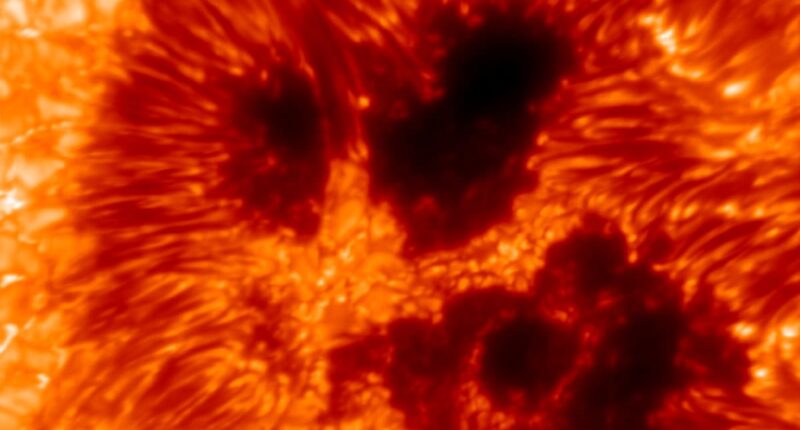It’s the super-hot, churning ball of plasma whose surface reaches temperatures of 5,500°C (10,000F).
Now, scientists have released the most detailed photo of our sun yet – and it gives a close-up glimpse of its intense magnetic energy.
The image was captured by the world’s most powerful solar telescope, which takes 2D snapshots of the sun at a range of wavelengths.
Three synchronized cameras capture several hundred images in just a few seconds, each using different settings, similar to capturing a series of photographs with various filters.
Combining these images allows for a 3D view of the sun’s structures – as seen in this remarkable picture.
The newly released image reveals a cluster of sunspots on the Sun’s surface, measuring approximately 25,000km by 25,000km.
Sunspots, which are regions of intense magnetic activity, are often the precursors to solar flares and coronal mass ejections. These phenomena are responsible for the awe-inspiring displays of Northern Lights seen on Earth.
The image achieves a spatial resolution of 10km per pixel – showing the sunspots in unprecedented detail.

The fascinating image depicts a group of sunspots, representing areas of high magnetic energy. Each pixel in the original image corresponds to a distance of 10 km (or 6.2 miles) on the surface of the Sun.

The Visible Tunable Filter’s (VTF) optical device, called an etalon, is pictured here. It consists of two reflecting plates which can measure small differences in the flux of light for different wavelengths
The Daniel K. Inouye Solar Telescope was first installed at the National Solar Observatory (NSO) near the summit of Maui’s Haleakalā volcano in 2022.
It has now achieved ‘first light’ – used to describe the first time a telescope lens is exposed to the night sky – with its most advanced instrument, the new Visible Tunable Filter (VTF).
Designed and built in Germany, the VTF arrived at the observatory last year and has since been carefully installed.
It weighs 5.6 tons and has a footprint roughly the size of a small garage, occupying two floors.
While it is not yet fully operational, science verification and commissioning are expected to begin in 2026.
‘Seeing those first spectral scans was a surreal moment,’ said Dr. Stacey Sueoka, Senior Optical Engineer at the observatory.
‘This is something no other instrument in the telescope can achieve in the same way.
‘It marked the culmination of months of optical alignment, testing, and cross-continental teamwork.

Near the summit of Maui’s Haleakalā, the Daniel K. Inouye Solar Telescope – and its set of cutting-edge solar instruments, such as the Visible Tunable Filter – is set to pave the way for a deeper understanding of our home star

Engineers and scientists work on the Visible Tunable Filter (VTF) inside the Coudé Lab at the Inouye Solar Telescope, preparing the instrument for its first light
‘We’re already seeing the instrument’s potential. This is only the beginning, and I’m excited to see what’s possible as we complete the system, integrate the second etalon [optical device], and move toward science verification and commissioning.’
The team said their new instrument may help reveal hidden details about the solar magnetic field, which is crucial for understanding solar flares and space weather.
The sun regularly displays powerful eruptions that hurl particles and radiation into space.
On Earth, this solar bombardment can trigger spectacular auroras – Northern Lights – but can also disrupt technical infrastructure and satellites.
Carrie Black, NSF program director, said: ‘When powerful solar storms hit Earth, they impact critical infrastructure across the globe and in space.
‘High-resolution observations of the sun are necessary to improve predictions of such damaging storms.’
On our increasingly technological Earth, sudden solar storms can cause devastating damage to critical infrastructure, and disable large portions of the electrical power grid, communications networks, or space systems.
This new instrument can analyse crucial properties such as plasma flow velocity, magnetic field strength, pressure and temperature.

A solar superstorm, strong enough to cause an ‘internet apocalypse’, knock out satellites and cripple clean water supplies could hit Earth ‘at any moment’, experts have warned (stock image)
‘The commissioning of VTF represents a significant technological advance for the Inouye Solar Telescope,’ said Matthias Schubert, VTF project scientist.
‘The instrument is, so to speak, the heart of the solar telescope, which is now finally beating at its final destination.’
Dr. Thomas Kentischer, KIS Co-Principal Investigator and key architect behind the instrument’s optical design, said: ‘After all these years of work, VTF is a great success for me.
‘I hope this instrument will become a powerful tool for scientists to answer outstanding questions on solar physics.’

















